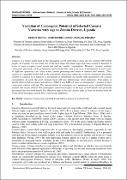| dc.contributor.author | Oloya, Benson | |
| dc.contributor.author | Adaku, Christopher | |
| dc.contributor.author | Andama, Morgan | |
| dc.date.accessioned | 2018-06-06T10:17:19Z | |
| dc.date.available | 2018-06-06T10:17:19Z | |
| dc.date.issued | 2018 | |
| dc.identifier.citation | Oloya, Benson; Adaku, Christopher & Andama, Morgan (2018). Variation of Cyanogenic Potential of Selected CassavaVarieties with Age in Zombo District, Uganda. Scholars World - International Refereed Journal of Arts, Science & Commerce, VI(I), 6–11. http://irmjcr.scholarsworld.net/serve?blob-key=AMIfv97syCRSgbz84jucpoP7MiiK12WSahIKP9Hik0gypwthrApK_bgWO98Vh3mzrdObXVlr_p_Ib2UG9oEKBfgpdXi647iYTwT_BTmsIeKIGGKxWOg5_hJMW_FAB6AmfWXJMvXtnRdTce-F6FUrd5xBoQpAMe9O_05JmOzEiJOTi7QyENLVtJ8 | en_US |
| dc.identifier.issn | 23203145 (Online) | |
| dc.identifier.issn | 23195789 (Print) | |
| dc.identifier.uri | | |
| dc.description.abstract | Cassava is a major staple food in the developing world, providing a basic diet for around 500 million people. In Uganda, it is currently one of the most important food crops and ranks second to bananas in terms of area occupied, total production and per capita consumption. However, cassava contains cyanogenic glycosides such as linamarin and Lotaustralin, which are toxic. Consumption of such toxins in sufficient quantities can cause acute cyanide poisoning and death in humans and animals. Thus, cassava is a possible health risk to the consumers. Awareness about the trend of cyanogenic glycosides content in cassava as it matures is paramount in minimizing the health risks associated with cassava consumption. As such, the most common local cultivars; Bisimwenge, Nyar-anderiano, Nyar-udota, in Zombo district and two improved cultivars: NASE 9 and TME 14, were investigated for variation in their cyanogenic content with age. The concentrations of cyanogens were determined using standard titration method. The results showed that cyanogeniccontent was highest at the ages of 8-10 months and generally decreased after the tenth month. It is therefore safer to harvest cassava after at least ten months when the levels of the hydrogen cyanide have reduced and stabilized. | en_US |
| dc.language.iso | en | en_US |
| dc.publisher | Scholars World-International Refereed Journal of Arts, Science & Commerce, | en_US |
| dc.relation.ispartofseries | Vol.VI;No.I | |
| dc.subject | Cassava | en_US |
| dc.subject | Cyanogenic potential | en_US |
| dc.subject | Food safety | en_US |
| dc.subject | Linamarin | en_US |
| dc.subject | Lotaustralin | en_US |
| dc.title | Variation of cyanogenic potential of selected cassava varieties with age in Zombo district, Uganda | en_US |
| dc.type | Article | en_US |

